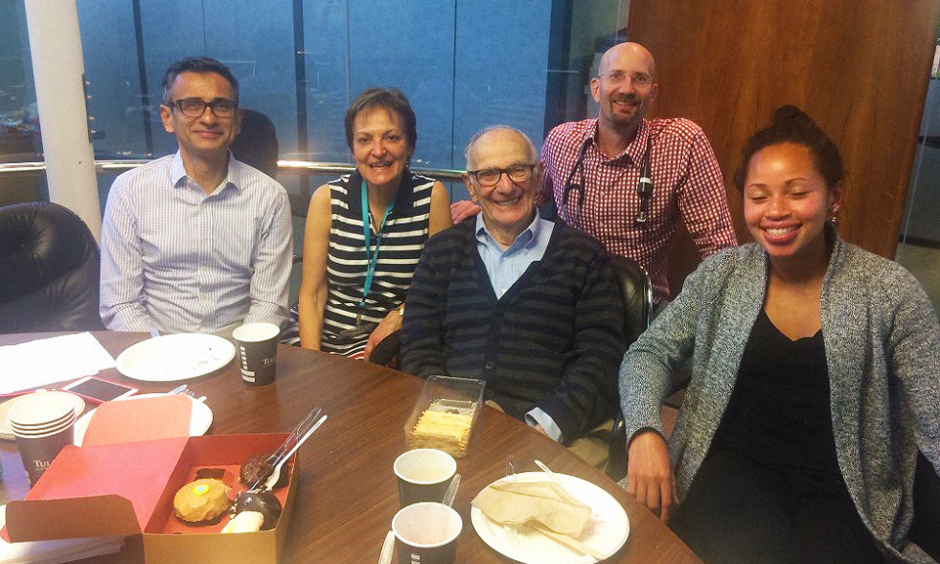An Interview with Dr Joshua Knowles, Stanford University
![]()
Written by James Coker | Reporter, European Medical Journal | @EMJJamesCoker
![]()
On 12th February 2018, the world received the sad news that Dr Gerald Reaven, the pioneering endocrinologist who introduced the concept of the metabolic syndrome back in 1988, had died at the age of 89.1 This syndrome, at the time coined ‘Syndrome X’, which is the link between insulin resistance and a combination of metabolic conditions such as increased blood pressure, high blood sugar, and abnormal cholesterol or triglyceride levels occurring together, is now recognised as an important indicator of the development of cardiovascular disease, stroke, and diabetes. Earlier, he had faced significant dissent when arguing for the existence of insulin resistance and its role in the development of Type 2 diabetes mellitus, eventually being proven correct largely through his own research. His legacy is therefore enormous, and having worked at Stanford University, California, USA since 1960, his influence is particularly felt in this institution. With 2018 marking 30 years since Dr Reaven’s pronouncement about the metabolic syndrome, EMJ spoke to Dr Joshua Knowles, Assistant Professor of Medicine (Cardiovascular Medicine), Stanford University, who worked closely with Dr Reaven for a number of years, about the work and continuing impact Dr Reaven is having, especially on the field of insulin resistance and its complex inter-relationship between different diseases. Additionally, we spoke in depth about the vital research Dr Knowles and others are now undertaking that could have major future implications in this area of medicine.
Seminal Moment
Dr Knowles could not overstate the vitality of that pivotal moment in 1988 when Dr Reaven, during the American Diabetes Association Banting award lecture, introduced the novel Syndrome X hypothesis.2 “I think it was a seminal moment in history for metabolic disease because it clearly summarised and laid out the arguments for insulin resistance, tissue insensitivity to insulin, as being a critical player in a number of disease states including diabetes, cardiovascular disease, and others. It really was a summary of decades of work that led into that and it has continued to play a critical role since then,” he commented.
Knowledge Gaps
Despite this, Dr Knowles emphasised that there are still significant gaps in scientific knowledge regarding insulin resistance and its impact on the metabolic syndrome. A particularly important one revolves around the causes of insulin resistance at a cellular level, with the lack of understanding in this area holding back the development of highly effective treatments. “We have hints at it, but the whole picture’s not been laid out and so until we understand that fully it’s going to be hard to, and it has proven hard to, develop novel therapies to combat insulin resistance,” he explained. “The therapies that we have so far are not great and often come with side effects that are not optimal.”
Dr Knowles also explained how important it is to establish a simple method of diagnosing insulin resistance in real-time at a laboratory level, such as a lipid panel for hyperlipidaemia, instead of relying on surrogate measurements. Finally, there remains a lack of understanding as to why insulin resistance leads to the various abnormalities that increase the risk of cardiovascular disease. Again, there are only currently hints and suggestions of why this might be the case, such as it causing changes in lipids and blood pressure, but the mechanisms behind this have not been proven.
Genetic Basis
Dr Knowles is therefore heavily focussed on uncovering the genetic basis of insulin resistance, an area that Dr Reaven played a major role in over recent years. Dr Knowles acknowledged the ability of the pre-eminent endocrinologist to set up large-scale projects that included researchers from around the world, citing several such collaborations that had taken place with colleagues in Europe largely due to Dr Reaven’s influence. “Jerry knew everybody in the community, so when you would call them and say ‘are you interested in collaborating?’, that would open a lot of doors,” he elucidated. “A lot of the studies were European funded and that collaborative aspect was another thing Jerry brought to the table. He was open and willing to collaborate with likeminded investigators and that was really important.”
Such European collaborations included the RISC and EUGENE2 trials,3 which were included in a genome-wide association study for direct measures of insulin sensitivity in 2,764 European individuals and replicated in another 2,860. Overall, the study supported a role for the NAT2 gene in insulin sensitivity, a potentially crucial finding. Another important study that Dr Knowles mentioned that is ongoing is evaluating the relationship between statin medications and diabetes.
Statin Medication
“There’s an emerging realisation that statins, which are the most commonly used medication in the world beside thyroid and pain medicines, while extremely effective in reducing the risk of cardiovascular disease, can cause a small increased risk of diabetes,” he explained. “This risk is known to be higher in individuals with insulin resistance, and it’s also been shown in modern genetic studies that if you have fundamental genetic changes that lead to changes in your lipid levels that also affects your diabetes risk, so there’s this complex interplay between diabetes risk and lipid levels and we don’t understand why that is. Jerry helped us submit and get a grant from the Doris Duke Charitable foundation to try and understand whether statins impair insulin resistance.”
Dr Reaven’s Legacy
Dr Reaven’s legacy does not solely lie with his extensive work in research, in which he co-authored over 800 papers, with several more yet to be published. It is also the impact he has had as a mentor on the careers of many researchers in the field of metabolic disease over many years, including future leaders like Drs Henry Ginsberg and Jerrold Olefsky. “He was directly supervising mentees until about 3 or 4 years ago, so he has a legacy of having trained generations of scientists,” added Dr Knowles.
Dr Knowles, who knew the Indiana-born doctor well both on a professional and a personal basis, described some of the characteristics that enabled Dr Reaven to produce such seminal work in his career. One trait that Dr Knowles admired in particular was his tenacity and being prepared to stand up for his beliefs despite the fact several of his theories, such as the existence of insulin and the metabolic syndrome, were doubted and even ridiculed at the time. Another was his work ethic, dedication, and passion for science, spending every possible moment he could to try and advance this field of medicine.
Collaboration
This attitude has inspired researchers such as Dr Knowles at Stanford University and it is no surprise this institution is so well regarded for the number of ground-breaking studies it consistently produces. A concept that Dr Reaven was closely linked to: collaboration, is embodied by the university he worked at for such a long period of time. Dr Knowles identified the close geographical distance between the school of medicine and the undergraduate institution as being crucial to this, as it enables easy access to and collaboration with people from both places. Additionally, the university’s close proximity to Silicon Valley has led to the institution becoming a highly entrepreneurial place, with a unique opportunity to work and collaborate with large venture capital firms.
Current Research
In the present, Dr Knowles’ research in cellular factors in insulin resistance continues unabated. While there is clearly still a long way to go in this area, he is encouraged by the progress being made. “The hints that we’re getting from large-scale genetic studies, not only our own but others, that are hinting at the genetic architectures, is teaching us the fundamental cellular basis of this; we’ve got the leads and now we need to track these down and figure it out,” he said.
Another project Dr Knowles is currently involved in that is linked to the cellular basis of insulin resistance is the creation of human model systems, based on stem cell technology, to study insulin resistance. In particular, he is part of a large consortium that have developed pluripotent stem cell models for this purpose; the follow-up studies are ongoing. “The idea is that if you take and make a stem cell from insulin or individual insulin resistance and then you differentiate those cells into the tissue of interest like muscle or fat, does that cell maintain an insulin resistance phenotype or not? Is this cell an autonomous programme and we’re starting to see hints that it is. That’s another area that I’m keenly interested in,” he explained.
Importance of Understanding Insulin Resistance
Fully understanding the mechanisms behind insulin resistance to ultimately aid the development of effective therapies is becoming increasingly more important in the context of growing insulin resistance worldwide,4 a fact linked to the greater prevalence of obesity. This emphasises the importance of continuously building upon the work of Dr Reaven to gain a thorough comprehension of the mechanisms of insulin resistance and its role in the development of cardiovascular disease, stroke, and diabetes. This is something that Dr Knowles is determinedly undertaking, and here at EMJ we eagerly await the findings from studies that are currently taking place, as well as those being planned for the future.
REFERENCES
- Stanford Medicine. Gerald Reaven, scientist who coined ‘Syndrome X,’ dies at 89. 2018. Available at: http://med.stanford.edu/news/all-news/2018/02/gerald-reaven-stanford-scientist-who-coined-syndrome-x-dies-at-89.html. Last accessed: 13 March 2018.
- Reaven GM. Banting lecture 1988. Role of insulin resistance in human disease. Diabetes. 1988;37(12):1595-607.
- Knowles JW et al. Identification and validation of N-acetyltransferase 2 as an insulin sensitivity gene. J Clin Invest. 2015;125(4):1739-51.
- World Health Organization. Global Report on Diabetes. 2016. Available at: http://apps.who.int/iris/bitstream/10665/204871/1/9789241565257_eng.pdf. Last accessed: 13 March 2018.
Click here to access Stanford University’s obituary of Dr Gerald Reaven.








